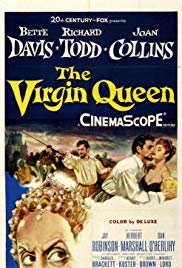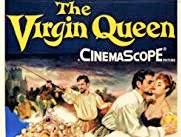The Virgin Queen *** (1955, Bette Davis, Richard Todd, Joan Collins, Herbert Marshall, Jay Robinson, Dan O’Herlihy) – Classic Movie Review 7708
Director Henry Koster’s 1955 historical drama The Virgin Queen provides a useful showcase for Bette Davis to re-create her superb Queen Elizabeth I characterisation from the classic The Private Lives of Elizabeth and Essex (1939), but now in shaven-headed, bewigged old age.
This time it is 1581 and The Virgin Queen is mooning over Sir Walter Raleigh (Richard Todd), who famously lays down his cloak in a puddle for her, winning her heart, but then infuriates her by marrying lady-in-waiting Bess Throckmorton (Joan Collins).
The Virgin Queen is quite a pretty looking movie, shot by Charles G Clarke in CinemaScope and colour, with notable production design by Lyle R Wheeler and Leland Fuller, and lovely Oscar nominated costumes by Charles LeMaire and Mary Wills, as well as a strong score by Franz Waxman, but it is unmemorable apart from a commandingly imperious Davis. She is more or less the whole show, but then her performance is quite a showstopper.
Also in the cast are Herbert Marshall as Lord Leicester (Robert Dudley), Robert Douglas as Sir Christopher Hatton, Romney Brent as the French Ambassador, Jay Robinson as Chadwick, Dan O’Herlihy as Lord Derry, Leslie Parrish [Marjorie Hellen], Lisa Daniels, Robert Adler, Frank Baker, Barry Bernard, John Costello, Ashley Cowan, Lisa Davis, Noel Drayton, Arthur Gould-Porter, Nelson Leigh, Ian Murray, Rod Taylor, David Thursby, Terence de Marney and Margery Weston.
The Virgin Queen is directed by Henry Koster, runs 92 minutes, is made and released by 20th Century Fox, is written by Harry Brown and Mindret Lord, based on the story Sir Walter Raleigh by Harry Brown, is shot by Charles G Clarke in CinemaScope and colour, is produced by Charles Brackett, is scored by Franz Waxman, and is designed by Lyle R Wheeler and Leland Fuller.
Australian actor Rod Taylor appears uncredited in his first Hollywood film in a short scene with an unidentifiable accent as the Welsh Corporal Gwilym.
It is shot far for merry England on Stage 8, 20th Century Fox Studios , Los Angeles.
Queen Elizabeth looks through her window with a telescope, which was invented in 1608, five years after her death.
In the same year Charles LeMaire won the Academy Award for Best Costume Design for Love Is a Many-Splendored Thing (1955). He won three Academy Awards and had an additional 13 nominations.
© Derek Winnert 2018 Classic Movie Review 7708
Check out more reviews on http://derekwinnert.com



